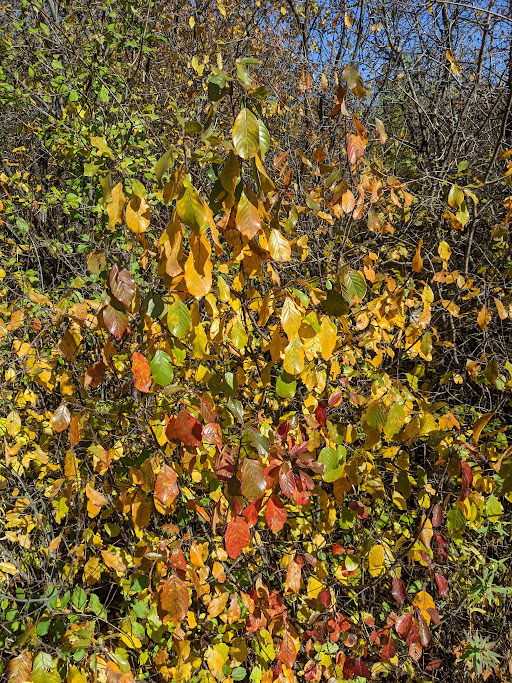by Fred Schueler & Aleta Karstad, Fragile Inheritance Natural History
In our 1995 survey of the ecology of the Kemptville Creek drainage basin, there was an entry for:
“Rhamnus frangula (Glossy Buckthorn). Widespread and Invasive. Seemed to become much more frequent near Bishops Mills about 1991. It may come to be a more important invader than R. cathartica because it invades wetland as well as upland habitats.”
This is a forecast which has come true, and many roadsides are now lined with the insipid yellow-orange of the autumnal foliage of this species. It is now usually called Frangula alnus because it differs from the Rhamnus Buckthorns in flower structure, its thornlessness, and its fragile (frangulous) wood, and genetic analysis has confirmed the difference between the genera. Glossy, Smooth, Alder, Columnar, Arrowwood, Fen, Persian Berries, Tallhedge, Breaking, European, Black, or Shining Buckthorn are recorded as English names.

This is a shade-tolerant wide-leaved shrub, with thornless speckled twigs and pale-flecked grey bark, growing to a height of 7 m, and bearing 6-10 mm black berries in years when it fruits. It is native to Europe, northernmost Africa, and western Asia, and it was probably introduced to North America before 1800, but did not become widespread until the early 1900s. In Ontario, it was introduced to London (1898), Ottawa (1899) and Guelph (1906), and was largely restricted to these urban habitats until after 1950.
Since showing up on our land in Bishops Mills around 1991, it has spread in oldfields and fencerows, and in the woods has widely displaced native understorey shrubs and herbs. Toxins that leach out of the leaves are known to inhibit the growth of other plants, and to poison tadpoles in adjacent ponds. It has so crowded out reproduction of forest trees that it is subject to herbicidal control in Limerick Forest.
The field east of County Road 18 where we grazed goats in the early 1980s is now a dense low woodland of the two invasive Buckthorn species, with only a few sugar maples and white elms. In 2013, we collected samples from 30 Frangulous plants from the roadside here, and sent them to Belgium for a study which, “using a set of annotated single-nucleotide polymorphisms”, concluded that “patterns of invasion through transatlantic trade from a limited number of European port regions led to the establishment of bridgehead populations with high allelic richness, allowing continuous secondary migration to natural areas.”
Like so many invasive plants, Frangulous Buckthorn has no insect pests, and none have been found in Europe that could be imported for biological control. In our 2005 summary of invasive plants in Limerick Forest, we recommended “recreational slashing” as the only control method (we use a Swedish Brush Axe from Lee Valley Tools), but while this is good exercise, and takes down the larger stems, the stumps sprout, and seeds fallen from the shrubs, or dispersed by birds, make dense thickets of seedlings. Conservation Authorities have staff who are licensed to apply herbicides to stumps. Seedlings up to about 50 cm to 1 m height can be uprooted by hand, larger ones can be uprooted by a weed wrench, and sprouting from stumps of larger stems can be prevented by bagging in black plastic or covering the stump with a scrap of old carpet.
With no prospects of biological control, Eternal Vigilance is the only way of dealing with the invasive Buckthorns, and the control process must be more nearly a sport than a project. If anyone wants to discuss control, or visit our control efforts on our land, or in the “Buckthorn to Maple Grove,” they can contact us at bckcdb@istar.ca.





